Conozcamos a Villa Guamá: Un entorno especial para el turismo en Cuba || Let's get to know Villa Guamá: A special environment for tourism in Cuba
¡Arrojen rápido nuestros tesoros a la laguna! Ningún desconocido nos quitará lo que es de nuestra comunidad.
Si un lugar turístico marca la diferencia en Cuba es Villa Guamá, ubicada en la provincia de Matanzas, en la Ciénaga de Zapata. El principal humedal de las islas del Caribe.
Desde pequeño, disfruté con mis padres, hermana, y mi abuelo, vacaciones en ese bello lugar, ya que ahí, el contacto con la naturaleza es directo y la pesca era segura.
Por eso, hoy les hablaré de este centro turístico, que en lo personal me encanta. La villa queda a 142 km de La Habana. En auto, nos toma promedio como 3 horas de viaje.
El lugar está estructurado por varias partes: La Boca o su zona inicial; el canal principal que lleva a la gran laguna; y las islas, con su museo y cabañas de renta.
La Boca
Nombre que da entrada a la villa. Ahí encontramos cafeterías, restaurantes, pequeñas tiendas donde se vende artesanía, y el criadero de cocodrilos.
El bar restaurante el Ranchón, queda a la izquierda y lleva como logo, la figura de un cocodrilo. En su área de Parrillada, se puede degustar hasta su carne. Algo que es típico en la zona de la ciénaga.
En ese trayecto, podemos ver un mini parque natural donde puedes conocer varios animalitos, como jutías, iguanas, venados, especies de jicoteas, y un pez prehistórico, que solo se encuentra en ese predio: el Manjuarí, un fósil viviente.
Al final se llega al criadero de cocodrilos, donde las personas, podrán ver como se alimentan, la interacción en su medio, y hasta podrás tocar con tus manos, a un lindo cocodrilo bebé.
Quickly throw our treasures into the lagoon! No stranger will take from us what belongs to our community.
If a tourist place makes the difference in Cuba is Villa Guamá, located in the province of Matanzas, in the Ciénaga de Zapata. The main wetland of the Caribbean islands.
Since I was a child, I enjoyed with my parents, sister, and my grandfather, vacations in that beautiful place, since there, the contact with nature is direct and fishing was safe.
That is why today I am going to tell you about this resort, which I personally love. The village is 142 km from Havana. By car, it takes us an average of about 3 hours of travel.
The place is structured in several parts: La Boca or its initial zone; the main channel that leads to the great lagoon; and the islands, with its museum and cabins for rent.
La Boca
Name that gives entrance to the village. Here we find cafes, restaurants, small stores selling handicrafts, and the crocodile farm.
The Ranchón bar-restaurant is on the left and has a crocodile as its logo. In its barbecue area, you can even taste its meat. Something that is typical in the area of the swamp.
On the way, we can see a mini natural park where you can meet several animals, such as hutias, iguanas, deers, freshwater turtles, and of a prehistoric fish, which is only found in this area: the Cuban gar, a living fossil.
At the end we arrive at the crocodile farm, where people can see how they feed, the interaction in their environment, and you can even touch with your hands, a cute baby crocodile.
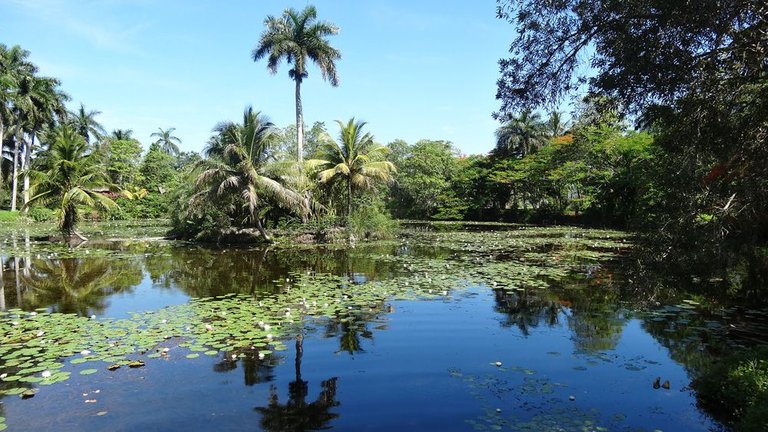
[Humedales en la zona de la Boca/Wetlands in the Boca area]
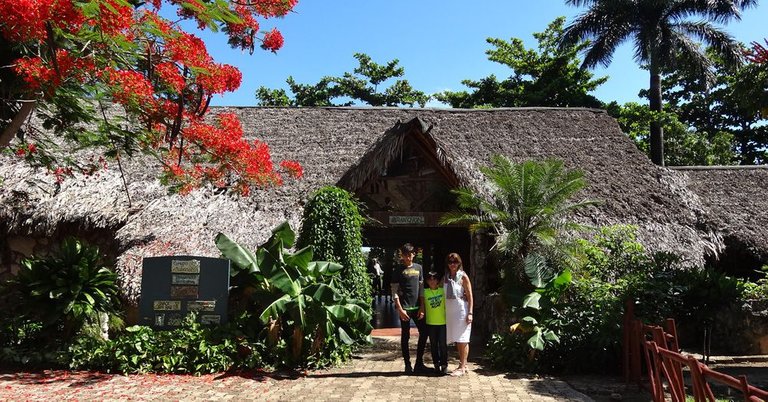
[Bar Restaurante “El Ranchón”/Bar Restaurant “El Ranchón”]
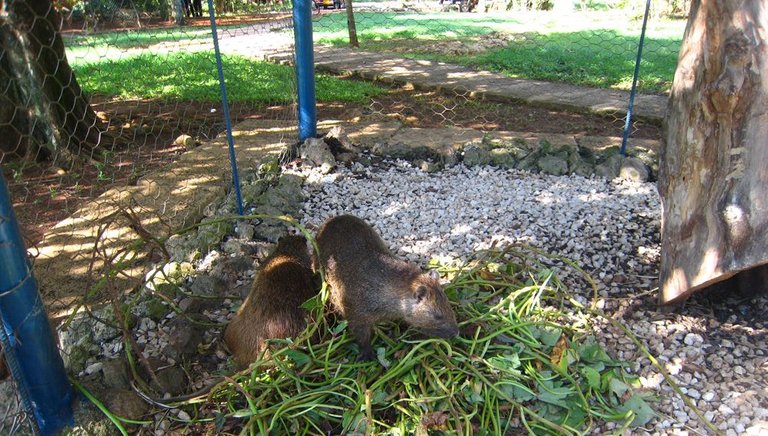
[Jutías/Hutias]
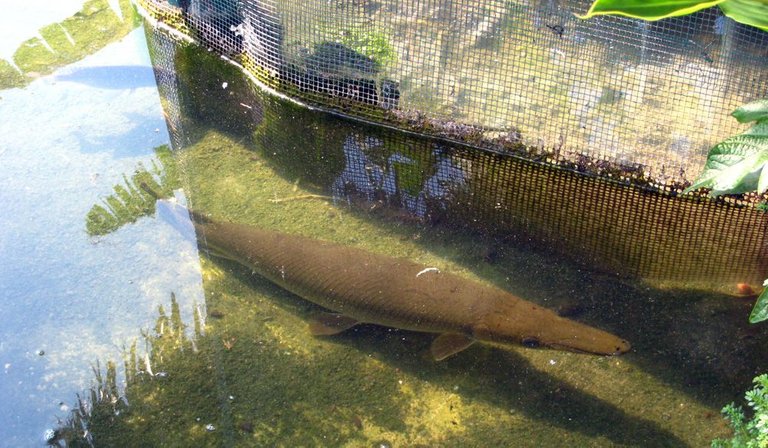
[Manjuarí cubano/ Cuban gar]
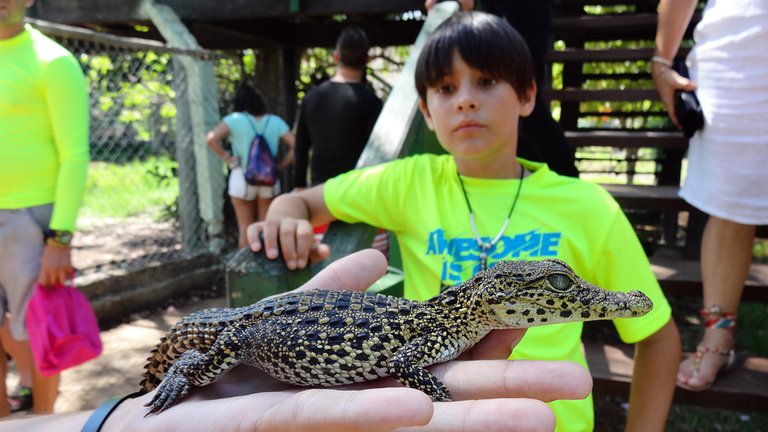
[Cocodrilo bebé/Baby crocodile]
A la derecha de la Boca, encontramos otro restaurante y una tienda pequeña de artesanía. Al final, se llega al embarcadero náutico, donde se alquilan las lanchas y botes para dar recorridos por los distintos canales del área.
Una exquisita diversidad de especies, se abre ante nuestros ojos, y hasta podrás encontrarte con aves endémicas, como la Gallinuela de Santo Tomás y la Ferminia.
Ahí escogimos la oferta de ir a la zona de las islas, en la embarcación más rápida. Unos botes largos, con motores fuera de borda, que concentran alrededor de 18 personas, con chalecos salvavidas de seguridad.
Por menos precio, puedes tomar, una embarcación de dos pisos, donde podrás ver los detalles de la trayectoria, demorando mucho más tiempo su recorrido.
El canal que lleva directo a la laguna
El bote se dirige, con una velocidad media, por el canal principal que llega a la gran laguna. Una distancia promedio entre 8 a 9 km, separa la Boca, de las pequeñas islas de la villa, donde solamente se accede cruzando el agua.
El paso de las embarcaciones que van y regresan, provocan en el agua del canal, ondulaciones y desniveles de la línea de superficie, que dejan manifiesto, ese color ocre, causado por los taninos de las plantas acuáticas y las ramificadas raíces, sumado a la gran presencia de la turba: un material orgánico, de color pardo, y rico en carbono.
Después de atravesar el canal, nos da la bienvenida la Laguna del Tesoro. La más grande de Cuba de agua dulce, con alrededor de 16 km de extensión.
Mis hijos, mi esposa, y todos; gozaban de esa experiencia veloz, donde la fuerza del desplazamiento del bote se incrementa al llegar a la laguna. Por la velocidad de la lancha, el agua se atomiza, refrescando los rostros, cuando el sol se hace sentir.
To the right of the Boca, we find another restaurant and a small handicraft store. At the end, we arrive at the nautical pier, where boats are rented to take tours through the different canals of the area.
An exquisite diversity of species opens before our eyes, and you can even find endemic birds, such as the Zapata rail and the Zapata wren.
There we chose the offer to go to the area of the islands, in the fastest boat. Some long boats, with outboard motors, that concentrate about 18 people, with safety life jackets.
For less, you can take a double-decker boat, where you can see the details of the trajectory, taking much longer.
The channel that leads directly to the lagoon
The boat heads, with an average speed, through the main channel that leads to the large lagoon. An average distance of 8 to 9 km separates La Boca from the small islands of the village, which can only be reached by crossing the water.
The passage of the boats that go and return, cause ripples and unevenness of the surface line in the water of the channel, that leave manifest, that ocher color, caused by the tannins of the aquatic plants and the branched roots, added to the great presence of turba: an organic material, of brown color, and rich in carbon.
After crossing the channel, we are welcomed by the Treasure Lagoon. The largest freshwater lagoon in Cuba, it is about 16 km long.
My children, my wife, and all of us enjoyed this fast experience, where the force of the boat's displacement increases when it reaches the lagoon. Because of the speed of the boat, the water atomizes, refreshing the faces, when the sun makes itself felt.
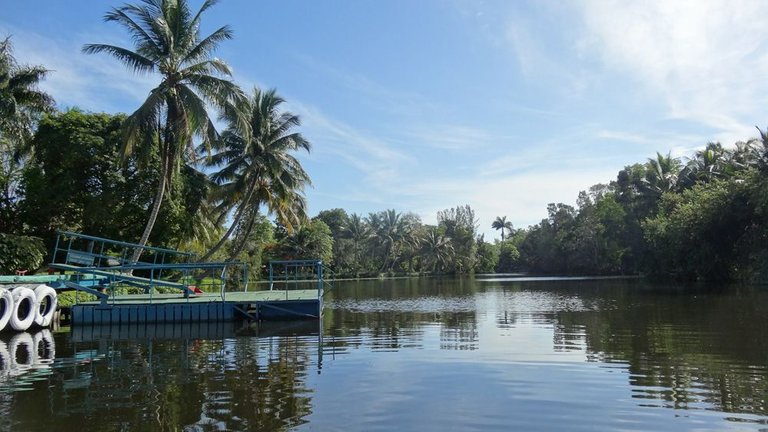
[Embarcadero en la zona de Boca de Guamá/Pier in the Boca de Guamá area]
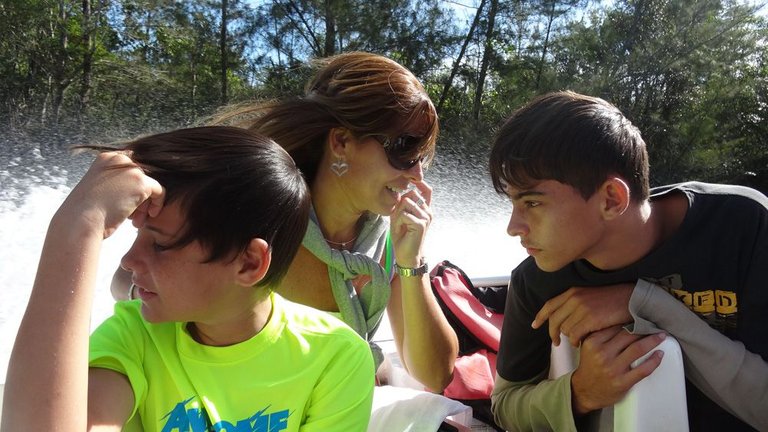
[Se refrescan la cara con salpicaduras de agua /They refresh their faces with splashes of water]
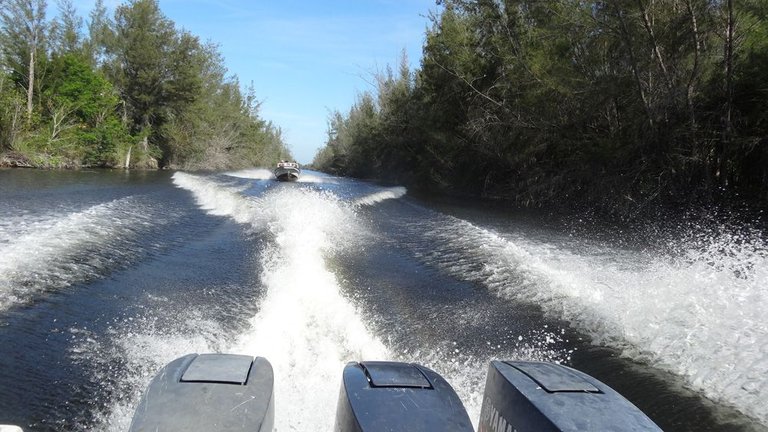
[Navegando por el canal principal hacia la laguna /Navigating the main canal to the lagoon]
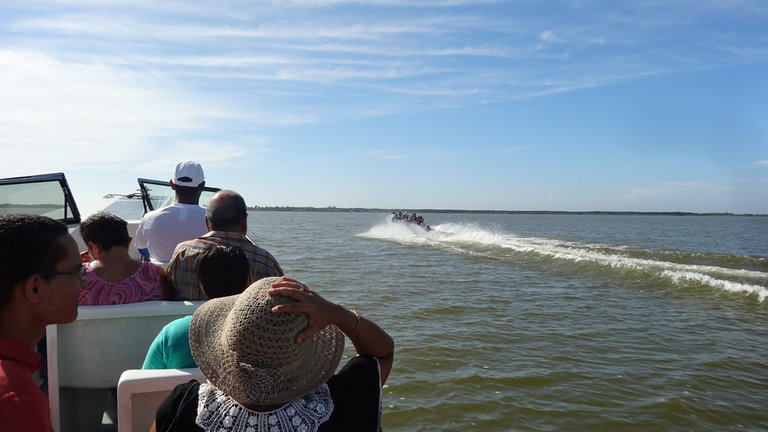
[La Laguna del Tesoro/The Treasure Lagoon]
¿Por qué el nombre de la «Laguna del Tesoro»?
Según cuenta la leyenda, cuando estaban arribando los conquistadores provenientes de España, en el siglo XVI, los indios arrojaron a la laguna sus riquezas, para evitar que llegara el patrimonio de la comunidad indígena, a manos de estos desconocidos que abordaron invasivamente a Cuba.
En esta gran laguna, habitan especies acuáticas diversas: Manatí, Sábalos, Manjuarí, Truchas y muchas otras formas de vida. Recuerdo que hace años, ahí se celebraban anualmente, los Torneos Internacionales de la Pesca de la Trucha.
A su vez, se pueden encontrar cocodrilos, que cuando son divisados, se capturan para ser llevados al criadero para su control, desarrollo, y hasta para su consumo regulado.
Las islas, el museo, y la infraestructura de la villa para el hospedaje turístico
La laguna finaliza con la entrada a las distintas islas, donde se divisa a la derecha, la Aldea Taína. Pasando unos metros, las embarcaciones llegan a la zona, donde se encuentra el Bar Indio.
Antes de llegar a ese lugar gastronómico, tienes una tienda, donde puedes comprar hasta pequeños cocodrilos disecados con un buen trabajo de taxidermia, ropa ligera, cuadros al óleo, calzado y otros detalles artesanales.
Los pasos para caminar, son hechos de tablas de madera, que están sobre el nivel del área verde.
Era hora de comer algo, y nos sentamos en ese bar techado y abierto en sus lados. Quisimos degustar la carne de cocodrilo, una primicia para mis hijos y su mamá. Carne que extraen de la cola del reptil, y la sirven en pedacitos fritos, junto a rodajas de limón.
Nos salió a gloria, y más, sabiendo que nuestras papilas gustativas, estaban chocando con un alimento no habitual. Un platillo gourmet para nuestros paladares.
A pocos metros, un pájaro negro, con iris ocular amarillo, en una baranda de madera, tenía intenciones de sumarse a nuestra mesa. Tanto fue su voluntad, que saltó para unirse a nosotros. Probó la carne, y me dejó hasta tomarle una linda foto.
Hidratamos el cuerpo con refrescos, y los adultos con Saoco. Una bebida clásica cubana preparada originalmente con aguardiente de caña o ron blanco, vertido al interior, de la punta cortada de la fruta de un cocotero; para ser mezclada con su agua natural.
Hoy se sirve con una pajilla o absorbente, en la misma fruta, o en un vaso alto de cristal, donde le pueden agregar gotas de limón, azúcar y hielo picado.
Coctel que usaban los Mambises desde 1868 hasta el 1880, los que enfrentaron, como ejército independentista, al dominio español en nuestra isla; y que entonaban sus festejos con la frescura de un Saoco, cada vez que ganaban un combate.
En el lateral del bar, las personas se divierten, arrojando migajas de pan al agua, los que son devorados, en segundos, por los peces gato y otras especies.
Why the name of the "Treasure Lagoon"?
According to legend, when the conquistadors from Spain were arriving in the 16th century, the Indians threw their riches into the lagoon to prevent the patrimony of the indigenous community from reaching the hands of these strangers who invasively boarded Cuba.
In this great lagoon, diverse aquatic species inhabit: Manatee, Tarpons, Cuban gar, Trouts and many other forms of life. I remember that years ago, the International Trout Fishing Tournaments were held there every year.
Crocodiles can also be found there, and when they are spotted, they are captured to be taken to the hatchery for control, development, and even for regulated consumption.
The islands, the museum, and the infrastructure of the village for tourist lodging
The lagoon ends with the entrance to the different islands, where the Taino Village can be seen on the right. After a few meters, the boats reach the area, where the Bar Indio is located.
Before reaching this gastronomic place, you have a store where you can buy even small stuffed crocodiles with a good work of taxidermy, light clothing, oil paintings, footwear and other handcrafted details.
The walking steps are made of wooden planks, which are above the level of the green area.
It was time to eat something, and we sat down in this roofed and open bar on its sides. We wanted to taste the crocodile meat, a first for my children and their mother. Meat extracted from the reptile's tail, and served in small fried pieces, along with slices of lemon.
We enjoyed it to the fullest, and even more so, knowing that our taste buds were hitting an unusual food. A gourmet dish for our palates.
A few meters away, a black bird, with a yellow eye iris, on a wooden railing, had intentions of joining our table. So willing was he, that he hopped up to join us. It tasted the meat, and even let me take a nice picture of it.
We hydrated our bodies with soft drinks, and the adults with Saoco. A classic Cuban drink originally prepared with aguardiente de caña or white rum, poured inside, from the cut end of the fruit of a coconut tree; to be mixed with its natural water.
Today it is served with a straw or absorbent, in the same fruit, or in a tall glass, where you can add drops of lemon, sugar and crushed ice.
Cocktail used by the Mambises from 1868 to 1880, those who faced, as an independence army, the Spanish domination in our island; and who sang their celebrations with the freshness of a Saoco, every time they won a combat.
On the side of the bar, people have fun, throwing bread crumbs into the water, which are devoured, in seconds, by the catfish and other species.
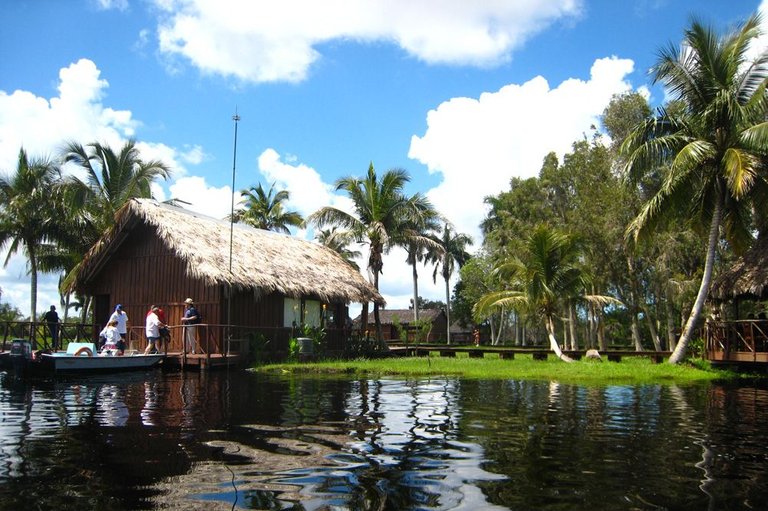
[Llegada al muelle en la zona del Bar Indio/Arriving at the dock in the area of the Bar Indio]
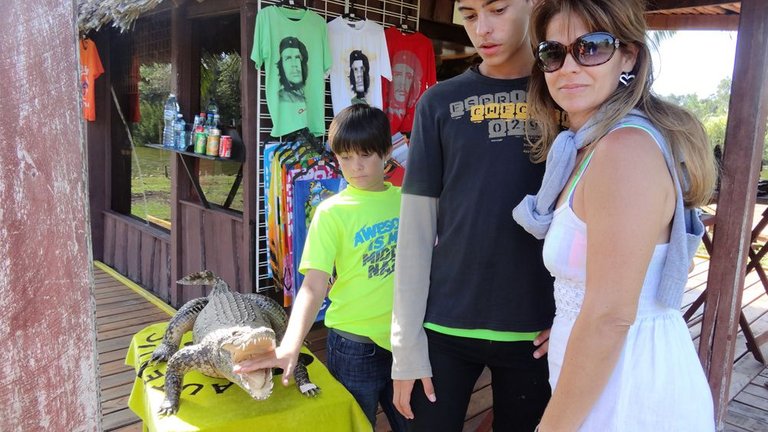
[Tienda de souvenirs/Souvenirs store]

[Caminos de madera y entrada al Bar Indio/Wooden walkways and entrance to the Indian Bar]
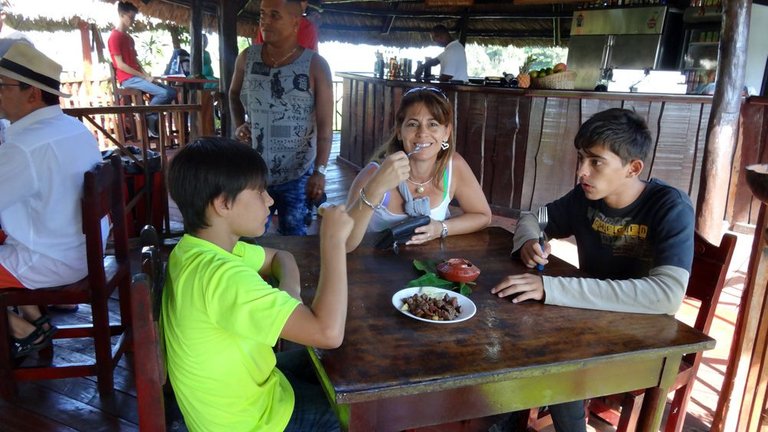
[¿Quién será el primero en degustar la carne de cocodrilo? /Who will be the first to taste crocodile meat?]
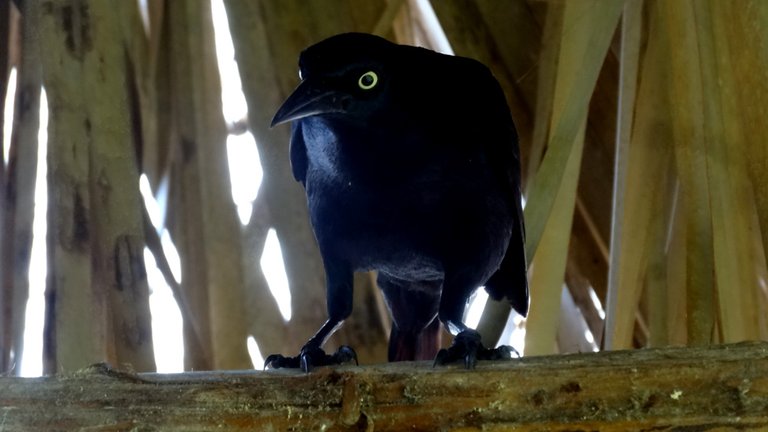
[El pájaro curioso se acercó por comida y lo inmortalicé con una foto/The curious bird came for food and I immortalized it with a photo]
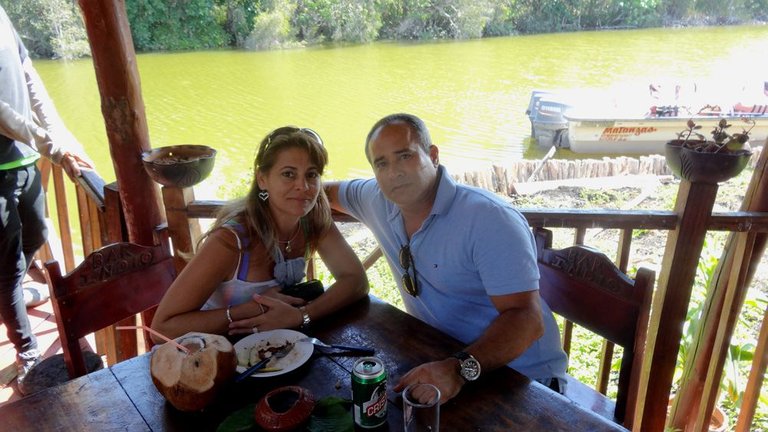
[Disfrutando de un sabroso cóctel Saoco /Enjoying a tasty Saoco cocktail]
De ese lugar, nos dirigimos a la Aldea Taína, llamada también el Batey Aborigen, un museo donde se exponen réplicas de bohíos y 25 esculturas a tamaño real, mostrando el trabajo que desempeñaban los aborígenes taínos en esa zona, antes de la intrusión europea, ejemplo: pesca, caza, siembra, recolección, etc.
Una hermosa obra de arte, que nos regaló la escultora Rita Longa, en 1999.
Desde ahí, puedes ver algunas de las 47 cabañas, usadas para la renta y emplazadas en la isla. Estructuras con un diseño arquitectónico atractivo, parecido a los bohíos de nuestros aborígenes. Construidos, con paredes de madera, y techos de guano, provenientes de la palma real.
Se asientan en el borde de las islas. Tienen una parte en la tierra, y otra que da al agua, sostenida por pilotes gruesos de madera.
De niño, recuerdo como cada cabaña tenía su botecito con remos, y uno podía pescar, desde la parte lateral y trasera de la casa; o salir con el bote, por los vericuetos canales que rodean a las distintas islas. Las que se conectan por puentes elevados, a través de sus caminos rasantes de madera. Trasladando a los turistas, al área de recepción, la piscina, las cafeterías, bares, restaurantes, zona de renta de botes, y otros objetos de diversión.
Tras recorrer la Aldea Taína, regresamos con la misma embarcación, a la zona de la Boca. Ahí compramos souvenirs como recuerdo: collares con dientes de cocodrilo.
Para finalizar nuestra excursión, les tomé una foto, junto a la escultura del animalito que encarna a Guamá: el Cocodrilo.
Mi familia, ha disfrutado mucho, los dos viajes que hemos realizado, por un día, a la villa. Espero en algún momento, hospedarme con ellos, aunque sea por un fin de semana, y que puedan vivir nuevas experiencias, pasando más tiempo en ese mágico lugar.
Deseamos, poder remar en la laguna y sus canales, pescar y liberar los peces capturados, deambular caminos sinuosos y elevados de madera, bañarnos en esa pequeña piscina con agua amarilla, ver los shows nocturnos temáticos al estilo taíno. Sentir en la noche el sonido de muchas especies, dormir en un bohío con ranitas e insectos que visitan las cabañas, y hasta soportar las picadas de los mosquitos.
En fin, deseo que sientan la magia de ese hermoso y único lugar.
En Guamá uno se fusiona, y siente en carne propia, sus verdaderos tesoros: la belleza de sus ecosistemas, los paisajes naturales y su rica biodiversidad.
Villa Guamá y el vertebrado que lo representa, dignifica a nuestro archipiélago; porque no existe otro país en el mundo, con forma de cocodrilo.
... y de la misma forma que a estos, debemos cuidar a nuestra isla, con ese mismo amor, con la que protegemos a nuestros antiguos reptiles.
From there, we went to the Taino Village, also called the Aboriginal Village, a museum where replicas of huts and 25 life-size sculptures are exhibited, showing the work performed by the Taino aborigines in that area before the European intrusion, for example: fishing, hunting, planting, harvesting, etc.
A beautiful work of art, given to us by the sculptor Rita Longa, in 1999.
From there, you can see some of the 47 cabins, used for rent and located on the island. Structures with an attractive architectural design, similar to the bohíos of our aborigines. They are built with wooden walls and guano roofs, coming from the royal palm tree.
They sit on the edge of the islands. They have a part on the land, and another part facing the water, supported by thick wooden piles.
As a child, I remember how each hut had its own little boat with oars, and one could fish from the side and back of the house; or go out with the boat, through the winding channels that surround the different islands. Those that are connected by elevated bridges, through their wooden paths. Transferring the tourists to the reception area, the swimming pool, the cafeterias, bars, restaurants, boat rental area, and other objects of amusement.
After touring the Taino Village, we returned with the same boat to the Boca area. There we bought souvenirs as souvenirs: necklaces with crocodile teeth.
To end our excursion, I took a picture of them, next to the sculpture of the little animal that embodies Guamá: the Crocodile.
My family has really enjoyed the two day trips we have made to the village. I hope at some point, to stay with them, even for a weekend, and that they can live new experiences, spending more time in this magical place.
We wish we could paddle in the lagoon and its canals, fish and release the fish caught, wander along the winding, elevated wooden paths, swim in that small pool with yellow water, watch the Taino-style themed night shows. Feel at night the sound of many species, sleep in a hut with frogs and insects that visit the cabins, and even endure the bites of mosquitoes.
In short, I want you to feel the magic of this beautiful and unique place.
In Guamá one merges, and feels in the flesh, its true treasures: the beauty of its ecosystems, the natural landscapes and its rich biodiversity.
Villa Guamá and the vertebrate that represents it, dignifies our archipelago; because there is no other country in the world, with the shape of a crocodile.
... and in the same way that we care for them, we must care for our island, with the same love with which we protect our ancient reptiles.

[Museo de la Aldea Taína: Sembrador de maíz/Taino Village Museum: Corn planter]
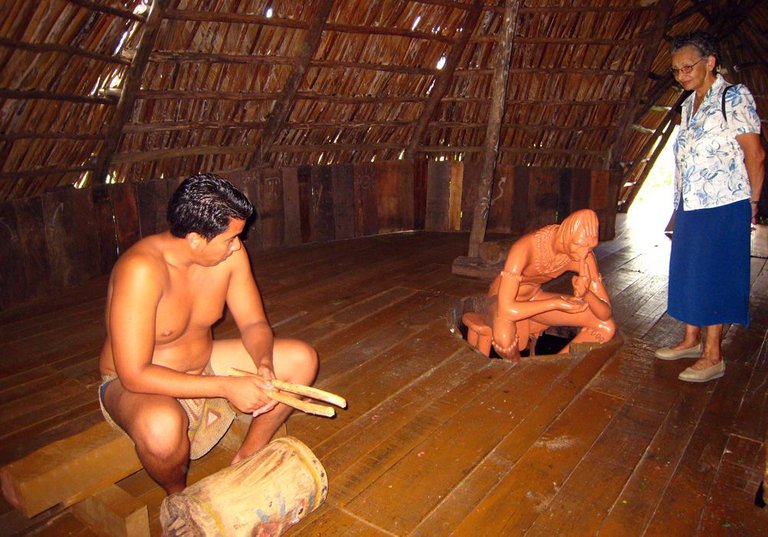
[Museo de la Aldea Taína: En el interior de una cabaña taína/Taino Village Museum: Inside a Taino hut]
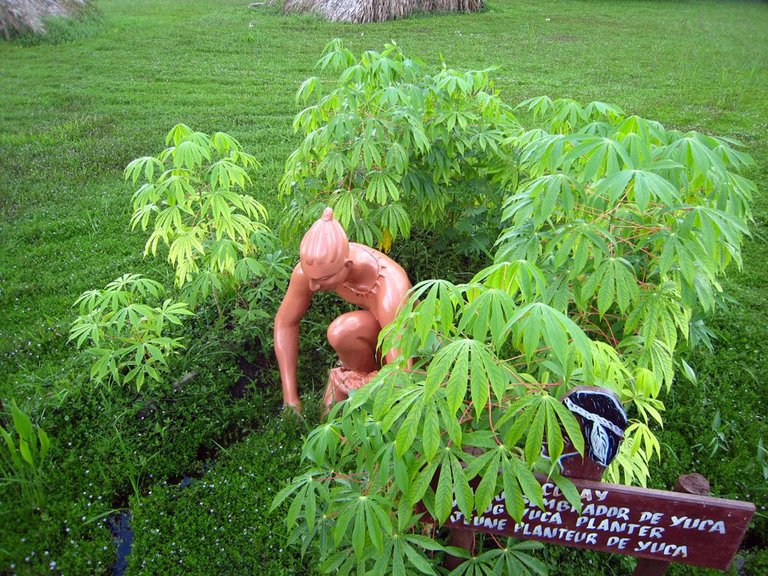
[Museo de la Aldea Taína: sembrador de yuca/Taino Village Museum: yuca planter]
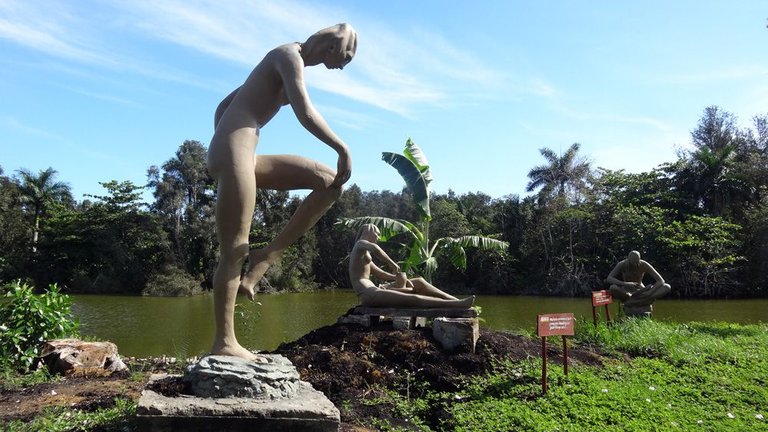
[Museo de la Aldea Taína: aborígenes trabajando la cerámica con barro/Taino Village Museum: aborigines working pottery with clay]
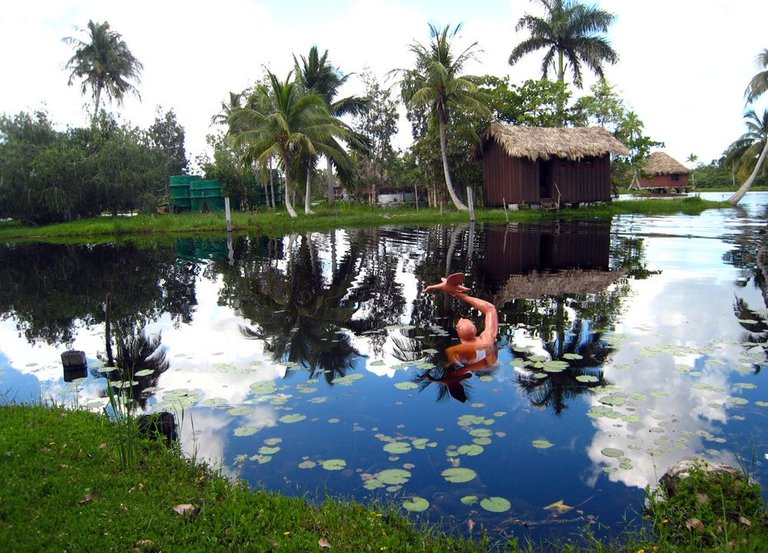
[Museo de la Aldea Taína: aborigen cazando aves dentro del agua/Taino Village Museum: aborigine hunting birds in the water]
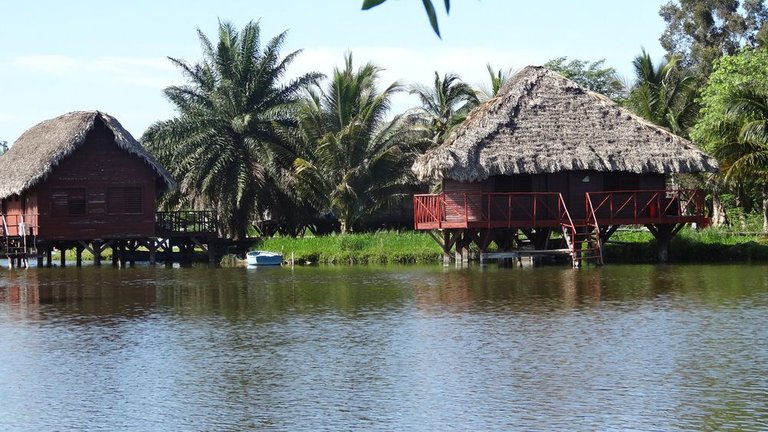
[Bohíos para el alojamiento turístico/Bohíos for tourist lodging]
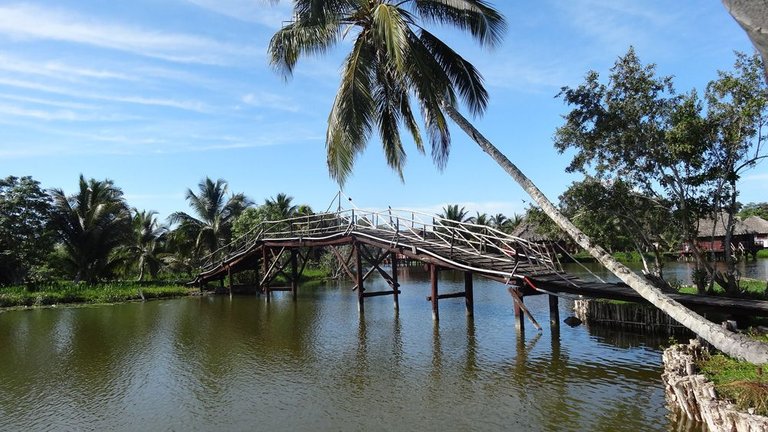
[Puentes elevados de madera entre las distintas islas/Elevated wooden bridges between islands]
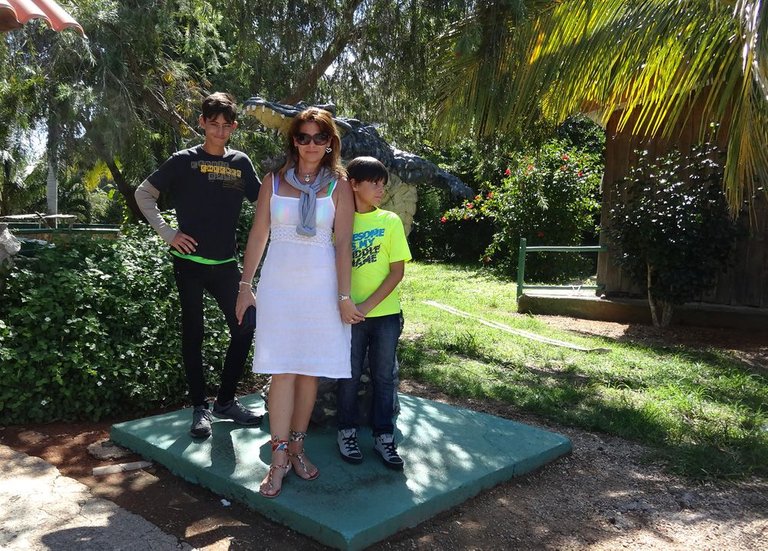
[Foto final en la figura artesanal que representa a “Villa Guamá”: el cocodrilo/Final photo on the handcrafted figure that represents “Villa Guamá”: the crocodile]
Fotos y Texto Original por/Photos and Original Text by Andrés Brunet
Datos históricos revisados/Revised historical data:
Villa Guamá
Mambises
Aborígenes de Cuba
Gracias por leer/Thank you for reading
Bienvenidos sus comentarios/Welcome your comments
¡Saludos infinitos!/Infinite greetings!
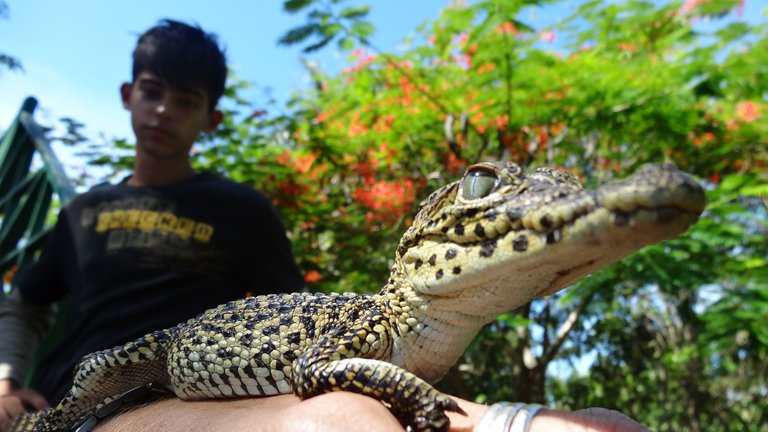
¡Felicidades! Esta publicación obtuvo upvote y fue compartido por @la-colmena, un proyecto de Curación Manual para la comunidad hispana de Hive que cuenta con el respaldo de @curie.
Si te gusta el trabajo que hacemos, te invitamos a darle tu voto a este comentario y a votar como testigo por La Colmena.
Si quieres saber más sobre nuestro proyecto, te invitamos a acompañarnos en nuestro servidor de Discord.
Excelente paseo por un lugar emblemático de nuestra geografía, Doctor Brunet. Qué bueno verlo disfrutar y luego me regocija tanto que sea capaz de traernos esta publicación bien detallada, para que el mundo conozca nuestros tesoros.
Gracias (es hermoso como ha terminado su artículo)
Gracias Nanixxx.
"Guamá" es un lugar mágico, una villa que todos debemos conocer, aunque sea, un día en Cuba. Es besar algo diferenciado, en contacto con la naturaleza, y sentir las huellas de especies únicas en esa zona.
Me alegro saber, que mi post, despertó tus letras. Saludos
Hola. Me gustó mucho tu escrito sobre Guamá, sobre todo las imágenes con las que complementas el relato. Hermosas fotos que recogen la belleza de lugar.
Me hiciste recordar la historia de la laguna, que no la recordaba... Muy bonita familia.
Saludos
Hola @jordy0827. Cada vez que he visitado a "Guamá", cómo le decimos en Cuba. Es un viaje energizante, que te transporta a épocas antiguas, donde te fundes con una parte real de nuestra historia.
El mismo nombre de la laguna, ya acuña mucho interés.
Si mis fotos, te hicieron disfrutar junto a la descripción, del relato, entonces sabrás que estando ahí, uno vuela de emoción hacia el pasado y logra vivenciar la grandeza de ese ecosistema humedal.
Mis saludos
Congratulations @abrunet! You have completed the following achievement on the Hive blockchain And have been rewarded with New badge(s)
Your next target is to reach 8000 upvotes.
You can view your badges on your board and compare yourself to others in the Ranking
If you no longer want to receive notifications, reply to this comment with the word
STOPCheck out our last posts:
Support the HiveBuzz project. Vote for our proposal!
El contacto con la naturaleza es esencial.
Muy cierto, ello energiza el alma y el cuerpo. Gracias